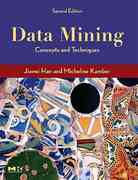Quantitative association rules may disclose exceptional behaviors within a data set, where exceptional can be defined based
Question:
Quantitative association rules may disclose exceptional behaviors within a data set, where "exceptional" can be defined based on statistical theory. For example, Section 5.1.3 shows the association rule
\[\text { gender }=\text { female } \Rightarrow \text { mean_wage }=\$ 7.90 / \text { hr }(\text { overall_mean_wage }=\$ 9.02 / h r),\]
which suggests an exceptional pattern. The rule states that the average wage for females is only \(\$ 7.90\) per hour, which is a significantly lower wage than the overall average of \(\$ 9.02\) per hour.
Discuss how such quantitative rules can be discovered systematically and efficiently in large data sets with quantitative attributes.
Section 5.1.3
As discussed earlier, relational and data warehouse data often involve quantitative attributes or measures. We can discretize quantitative attributes into multiple intervals and then treat them as nominal data in association mining. However, such simple discretization may lead to the generation of an enormous number of rules, many of which may not be useful. Here we introduce three methods that can help overcome this difficulty to discover novel association relationships: (1) a data cube method, (2) a clustering-based method, and (3) a statistical analysis method to uncover exceptional behaviors.....
Step by Step Answer:

Data Mining Concepts And Techniques
ISBN: 9780128117613
4th Edition
Authors: Jiawei Han, Jian Pei, Hanghang Tong





